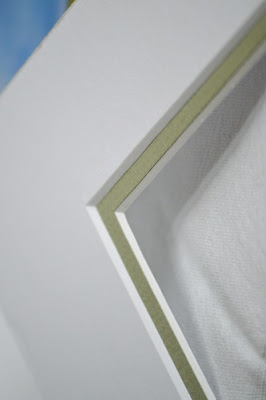 |
| lots of styles, lots of options |
I have a lot of frames that I either bought from garage sales, or purchase at craft stores. Before you put art in a frame, it's a good idea to 'audition' frame colors and styles by simply setting your art on top to see what it would look like. You'd be surprised how many times a great frame washes out or clashes with the piece you are wanting to put on display.

The way I like to display postcards is to mount them on a backboard and matt them. You will need to ensure that the matting you chose will be larger than the 4x6" art. It's nice to let it breath and have some room around the edges. In the case of my postcards, I put an equal amount of energry into the edges, so I don't mind showing them off. If you are buying pre-cut matting for a craft store, take a look at the corners. Over-cut matting is a 'no-no'. If you don't have a choice, you can try to press the over-cut lines down to make them less noticeable.
 |
| back board, mat (pictured face down), acid free archival glue, rotary cutter, cutting mat, ruler, spacers. |
To mount, you have lots of options. You can stitch your fibre art to a backing cloth and then stretch that over the backboard. You can do the same with a stiff watercolor paper. You can also mount directly onto acid-free mat board with an adhesive. Here as well, you have lots of options. You can buy mounting tape, double sided sticky tape, velcro/hook&loop mounting tape, or you can use fabric/paper glue in small dabs. * * * Ensure that anything you touch to your art is archival quality / acid free. Read labels. Try different things. See what you prefer.
I like to use the paper in the frames as a guide as to how large to cut the back mounting board and the mats. I don't keep them in the frames, I just use them as a guide. I do all my cutting with my quilt rulers, cutting mat, and rotary blades. I have an extra marked 'paper' since they go dull faster when cutting things like this. Rotaries and rulers make nice, straight, clean cuts. You can also use an Exacto-knife if you have that.
 |
| clean clean clean |
Fine embroidery tends to be the only fibre art that is put under glass to ensure longevity and protect delicate threads & intricate handwork. I put these postcards under glass as requested by the buyer. If you chose to use glass, you will need to clean it well. When it comes to little art, people look closely and so bits of dust or debris can be really obvious. Microfibre shammies work well. Do not use cleaners so that you can ensure that all the parts to the framing remain acid-free. It's handy to work in thin cloth gloves to keep natural finger oils off the matting and fingerprints off the glass.
It's really important that fibre art not contact the glass when framed this way. There are options here too. You can double up your mats. Sometimes they come precut this way as well and feature a secondary color.
 |
| pre-cut double matting from the craft store |
I've also seen them raised so that the two mats have a spacer between them. I make my own 'floating mats' by cutting up spare matting into 1/4" / 0.7cm strips. I glue those first to the underside of the matting like so.
 |
| creating a floating mat to keep the glass off the fibre art |
I like to put a dab of acid free glue to the mat before I place it on the backboard around the art. The reason for this is to prevent shifting during or after framing. There's nothing more frustrating than putting some are together and then finding it's all crooked and you have to take the whole frame apart again. (haha - from someone who knows...) Also, turn the piece to see that the space around is consistent. If you have one light source in the room while framing, shadows can throw you off.
 |
| raised / floating mats to protect the art cards |
Sign it! Sign your art. It's important. Could you imagine reading a good book and the author failed to leave their name on their work? Sign it. Date it too. I do this on the art, on the matting, on the back of the matting, and on the back of the frame. Artists/painters generally sign on the lower right. Quilt back labels are put on the lower left so that when it's displayed, you can flip that lower right corner and find the creator's name there tucked behind. Smart, huh!? : )
 |
| framed postcards, signed art |
I learned from my framer to wrap pieces individually and stack them face to face and back to back. This way, protruding hardware cannot scratch up the fronts of other frames. You can get the brown paper on rolls from post offices.
 |
| ready to go. |
This is basic, basic framing. You can get brad tools and replace all the hardware with proper picture hanging parts. Most cheap frames have weak saw-tooth hangers and do not hang well. They are also a no-no when hanging at shows. (Read the fine print before you enter anything.) After all is said and done, I have to tell you that I definitely prefer professional framing. I've had cheap frames fall right off the walls. It's also tough when you make art and then try to find a frame that fits! I've learned to make the art fit the frame. Postcards are easy though - at a standard 4x6" you just use a frame with a 5x7 cut space or larger. If you are framing for yourself and not for a buyer, then this DIY should do.
 |
| this one was professionally framed |
I find professional framing isn't that much more costly, especially if you stretch or mount your own work. Well there you go! I hope you enjoyed my little tutorial. : ) Postcards are meant to be loved and displayed.
Enjoy! (and yes you can 'Pin' from this post...)













10 comments:
GREAT instructions/tutorial. Thanks!
Very helpful, Monika, thanks a lot!
This is great info, Monika! Thanks!
I agree...great tutorial! Thanks for the information! ~Bee
Clear instructions! Thanks, Monika!
merci pour ce tuto sublime a plus
hello, just came across your blog while surfing the net. Just a few clarification notes regarding professional framing.
Want clean glass use good ole vinegar and water.
Using any kind of adhesives to mount fibre art is a major no, no please don't do it. My profession was picture framing (Two certificates for basic and advanced framing) and I've seen so much beautiful work deteriorating by people having used adhesives on the back of their work. Certain adhesives go brittle over time and most discolour turning yellow or brown which stains the textiles.
The only archival framing method for work on fabric is to "hand sew the textile to another piece of fabric and then stitch that fabric around archival foam core that is slightly smaller than the size of your frame to accommodate the fabric folded around the edges". One uses a lacing method across the back to block or stretch the fabric neatly around the archival foam core. That way there is no slippage. If its a tiny work then archival mat-board could be used rather than the thicker foam core.
Then place your mat over the the art piece and place into the frame. Once the work is nailed in the frame package, cover the back with paper by using double sided tape on the back of the frame to adhere the paper backing cover in place (this is the only area where adhesives are ok to use as its far away from the work) The paper backing helps keep dust out.
So, no there are not a lot of options if you are wanting the work to be preserved. I have re-framed pieces that have only been behind glass for 10 years yet the adhesives had discoloured and damaged the work. If you are going to go through the trouble of framing textiles, please do it conservational, especially if you plan on selling the work.
This is basic. For true conservation wood frame edges would also be sealed before work is placed in frame. Just be sure the textile work itself is not in contact with a wood frame as the lignin in wood can cause discolouring as well.
Oh and a note about picture framers, not all are trained, many just pick it up by working for someone else, many are not trained or studied conservation framing. Question them, are they certified and know conservation methods and make sure they use conservation materials. And yes it is more expensive, but is not your work worth it?
Tess
email me if you wish any clarifications, I would rather artists know how to preserve their work well.
Sorry for all the separate comments but I just realized your work is not on a stretched fabric base but floating within the frame. To float as your work is presented the textile should be stitched to archival mat board. This is done by using an awl to poke small holes through the mat where one would stitch through using tiny stitches to tack the textile to the mat. Of course its done in a manner where the stitching holes are hidden behind the work.
Or you could machine stitch a postcard size work to heavy water-colour paper the size of your frame if your machine can handle it, then place your mats over. I hope my comments are helpful to you. Tess
This is great! I use only archival or acid free products - paper, water based photo safe etc etc as recommended. There are adhesives & glue that are recommended and certainly most that are not. In fibre/textiles we use fusibles as well... fabric glue sticks that are acid free. I stitch through if the edges are covered or if it's a hooked piece. But I do mount smaller work. I would love to hear your thoughts on this, and thank you for the advice! : )
Post a Comment